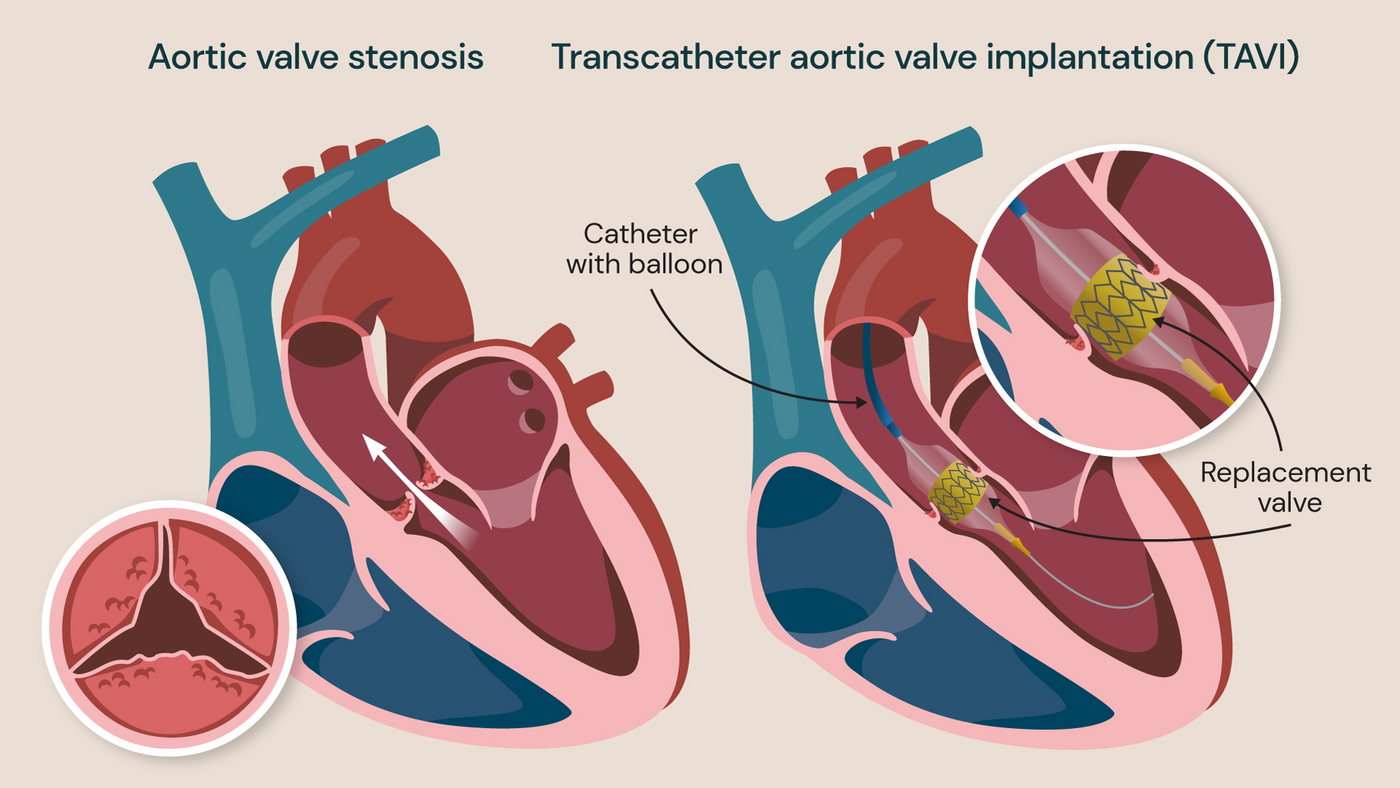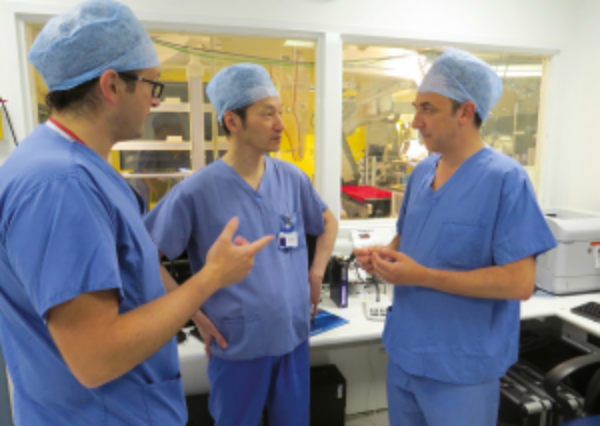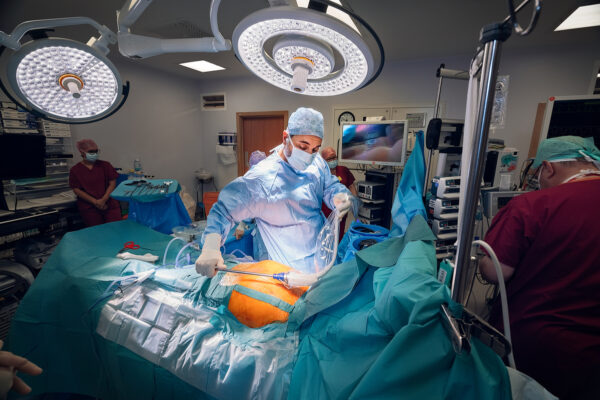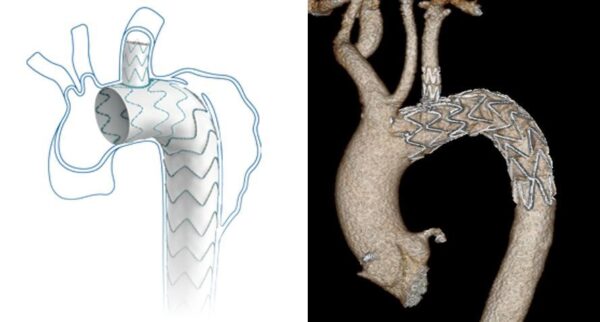Transcatheter aortic valve implantation (TAVI) is an alternative approach to conventional open-heart surgery. The procedure is not just for those who would benefit from a minimally invasive approach, it can show better results in candidates suitable for open-heart surgery too.
The TAVI procedure is mainly used to correct aortic stenosis, sometimes with aortic regurgitation – conditions that account for 75% of all patients with valve disease. Royal Brompton and Harefield Hospitals runs the largest transcatheter aortic valve implantation programme in the UK, carrying out hundreds of TAVIs since its start in 2007.

TAVI procedure: A new valve is inserted in position using a catheter.
Aortic valve disease
Cardiovascular disease (CVD) remains one of the leading causes of fatality in the Middle East. Faulty heart valves are a common cause of CVD and can be a result of age-related changes to the heart.
The aortic valve is one of four valves in the heart and is the outlet valve from the main pumping chamber. It controls the blood flowing out of the heart and around the body with thin leaflets of tissue that open and close when the heartbeats. Aortic stenosis is the most common and serious form of valve disease. The condition causes the leaflets to stiffen, which narrows the valve so that it does not open properly, making it harder for the heart to pump blood around the body. Aortic stenosis causes symptoms including shortness of breath, fainting, heart murmur, and fatigue.
Aortic regurgitation occurs when the aortic valve doesn’t close tightly and allows some of the blood that was pumped out of the left ventricle (the heart’s main pumping chamber) to leak back in. TAVI cannot be used for aortic regurgitation alone but it can be used for mixed aortic valve disease where the valve is both leaky and narrowed.
In severe cases of aortic stenosis, the only effective long-term treatment is to replace the valve. Severe aortic stenosis tends to present in people in their 70s and 80s, due to wear and tear, although others may develop this younger, even in childhood on rare occasions.
TAVI procedure
For those suffering from aortic stenosis, one of the only options in the past for treatment was open heart surgery to replace the valves that are failing. The TAVI procedure is a less invasive form of aortic valve replacement, whereby a new aortic valve can be implanted either via the arteries in the groin, the arm, directly into the aorta or via a small cut in the chest.
During the procedure, which can be performed under general or local anaesthetic, a catheter is guided along an artery to the patient’s heart using special scanning equipment. The new valve is then placed within the narrowed aortic valve and expanded to relieve the obstruction.
Dr Davies says: “Imaging is a very important part of the process. Computed tomography (CT) scans provide detailed images of the patient’s aortic valve, identifying the right size and type of replacement valve. A combination of a very low dose X-ray and, where necessary, an echocardiogram helps to guide the device into position and checks it is working properly.”
Since none of these methods require the breast bone to be cut or open-heart surgery to be performed, they are less traumatic than conventional surgical aortic valve replacement.
The Royal Brompton & Harefield Hospital team has expertise with many of the different TAVI devices currently available. They have considerable experience in using TAVI to treat previously implanted surgical aortic valves that are showing signs of degeneration.
TAVI programme
Royal Brompton and Harefield Hospitals combined are the only specialist centre in the UK with transcatheter programmes for all four of the heart’s valves: mitral, pulmonary and tricuspid as well as aortic. With aortic valve implantation, there is also a choice of two types of valve – a self expanding or balloon-expanding version.
Dr Davies explains: “Transcatheter aortic valve implantation is certainly less traumatic than open-heart surgery for many patients, especially if they have existing comorbidities. But Dr Davies says Royal Brompton and Harefield Hospitals now offers TAVIs to patients who are good candidates for open-heart surgery too.
He continues: “Recent clinical trials showed TAVI is as good as conventional surgery in those people. We now offer this approach more routinely to people in their late 60s and early 70s without other health problems.”
Patients with failing surgical valves made from tissue, which degenerate in 10 to 15 years, are also excellent candidates for TAVI, as younger people would otherwise need several open-heart surgeries in their lifetimes.
The Edwards SAPIEN 3TM transcatheter heart valve (THV) is a collapsible aortic heart valve that can be introduced into the body via a catheter-based delivery system.
The valve is designed to replace a patient’s diseased ‘native’ aortic valve without traditional open-heart surgery and while the heart continues to beat.
The Edwards SAPIEN 3TM THV is a biological valve built with animal tissue and replaces the diseased aortic valve. The valve is balloon-expandable and is estimated to last 10 to 15 years. The Edwards CommanderTM delivery system allows for accurate positioning of the THV within the native valve.
Benefits for patients
Most patients who have had TAVI find that their heart is almost immediately able to pump better as there is no longer any hindrance to blood leaving the organ.
In some cases, patients may take a little longer to recover. For example, an older person who has suffered severe heart failure for some time may take a few weeks to recover. However, their breathing will be better pretty much from the start.
Dr Davies explains: “The international expertise of our multi-disciplinary team can be invaluable in ensuring that patients with severe aortic stenosis have access to an alternative life-saving procedure. The Royal Brompton and Harefield Hospitals team carefully review each individual patient and advise which procedure is most suitable.”




